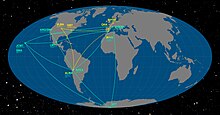EVENT HORIZON
 |
| EVENT HORIZON TELESCOPE |
What's an "event horizon" you wonder? It's the name of the imagined turbulence at the edge of a "black hole"--Google that for yourself--just before the light-and-mass forces drawn toward its massive gravitational field are pulled in and disappear. This "event" is predictable but not visible, except to radio telescopes tuned to a very short wavelength--1 meter--and focused on a source: the black hole imagined to be at the center of our galaxy called "Sagittarius A" (because it seems to be in that ancient Greek constellation).
Ozel remarked that the energy of this galactic black hole--if its radiation were visible--would be many times brighter than our own sun, even though it's 27,000 light years away from earth.
To detect the energy from the "event" at the edge of this black hole would require a radio telescope the SIZE of the earth! Ozel's solution: an array of telescopes distributed over the planet and precisely coordinated so that their recordings could be correlated for evidence of the event horizon 27,000 LY away.
After years of planning, construction, and coordination, the array of instruments--from the Arctic to the Antarctic, Arizona to Australia, Spain to Hawaii, Africa to South America--began to record data for 5 days in April 2017. Wow.
The weather was ideal all over the world! Now there's an event. The result was 3.5 PETABYTES of data! A "byte," you'll recall, is an 8-place binary set. A "petabyte" is one-thousand-billion bytes! The loads of hard drives filled hundreds of trucks and they all had to be transported here to Tucson. More wow.
When the analysis is complete, Ozel said, we'll know at least two things: that there really are black holes, and that we may have to revise our theory of gravity! Stay tuned...


0 Comments:
Post a Comment
<< Home